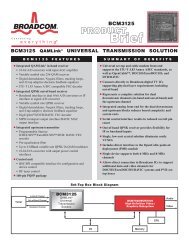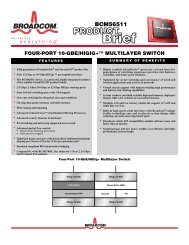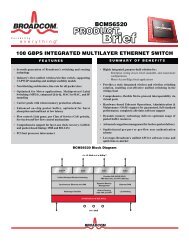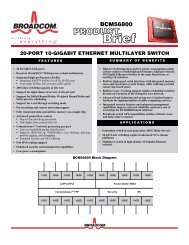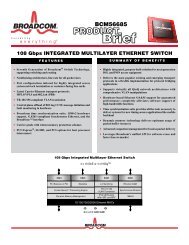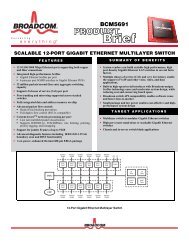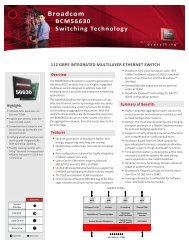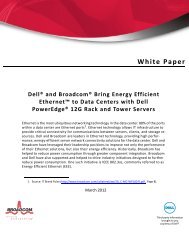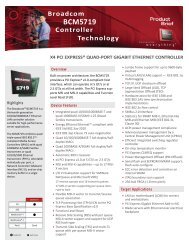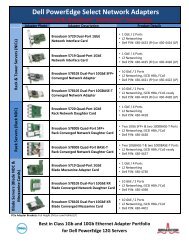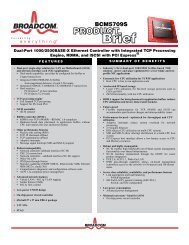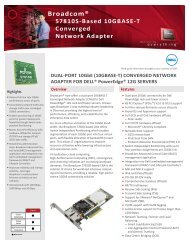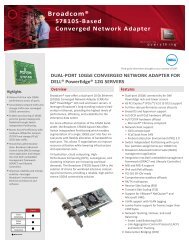Create successful ePaper yourself
Turn your PDF publications into a flip-book with our unique Google optimized e-Paper software.
®<br />
<strong>BCM5481</strong><br />
10/100/1000BASE-T GIGABIT COPPER TRANSCEIVER<br />
• Fully integrated 10BASE-T/100BASE-TX/1000BASE-T Gigabit<br />
Ethernet transceiver<br />
GMII, RGMII, and MII MAC interface options<br />
On-chip low-voltage regulators<br />
Fully compliant with IEEE 802.3, 802.3u, and 802.3ab standards<br />
0.13µ CMOS—low power and cost<br />
Low power<br />
- Less than 700 mW per port<br />
- Advanced power management<br />
Trace matched output impedance<br />
Line-side loopback<br />
Low electromagnetic interference (EMI) emissions<br />
Cable-plant diagnostics<br />
- Cable plant analyzer function detects cable plant impairments<br />
- Link quality indication LED<br />
- Automatic detection and correction of wiring pair swaps, pair<br />
skew, and pair polarity<br />
- Automatic MDI/MDIX crossover at all speeds<br />
Robust CESD tolerance<br />
Support for jumbo packets up to 10 KB<br />
IEEE 1149.1 (JTAG) boundary scan<br />
64-pin MLP, 68-pin MLP, 100-pin FBGA, and 100-pin QFP<br />
packages<br />
MAC<br />
FEATURES SUMMARY OF BENEFITS<br />
<strong>BCM5481</strong><br />
General Gigabit Ethernet Connectivity<br />
Transformer<br />
RJ-45<br />
Simplifies system and board design.<br />
- Reduced I/O pin requirements with RGMII (over 50%).<br />
- On-chip RGMII timing delay<br />
Provides interoperability with IEEE standard devices<br />
operating at 10 Mbps, 100 Mbps, and 1000 Mbps at half- and<br />
full-duplex.<br />
Lowers system bill of materials (BOM) cost and simplifies<br />
system design.<br />
Requires no airflow or heatsink.<br />
Eases system level debug.<br />
Reduces system design constraints to meet EMI emissions<br />
standards.<br />
Cable diagnostic function characterizes cable plant condition<br />
and immediately indicates cabling issues.<br />
- Prevents erroneous equipment return due to bad cable<br />
plants.<br />
- Prevents manufacturing fall-out due to bad cable plants.<br />
High CESD tolerance prevents equipment damage and<br />
return.<br />
Operates with larger packets for wider range of packet<br />
protocol support and improved efficiency.<br />
Ease of manufacturing with JTAG support, simplified power<br />
supply, and multiple MAC interfaces.<br />
BCM5645<br />
24FE +2G<br />
Switch<br />
BCM5248<br />
Octal<br />
10/100 Mbps PHY<br />
BCM5248<br />
Octal<br />
10/100 Mbps PHY<br />
<strong>BCM5481</strong><br />
<strong>BCM5481</strong><br />
BCM5248<br />
Octal<br />
10/100 Mbps PHY<br />
1000BASE-T Gigabit Uplink<br />
Transformer<br />
Transformer<br />
RJ-45<br />
RJ-45
TRD[0:3]±<br />
XTALI<br />
XTALO<br />
RDAC<br />
REGSUP[1:2]<br />
REGSENSE[2]<br />
REGBIAS<br />
REG_OUT[1:2]<br />
The <strong>BCM5481</strong> is optimized for low power and small footprint size to<br />
enable uplink and general Gigabit Ethernet connectivity applications. By<br />
lowering system cost and reducing power dissipation, the <strong>BCM5481</strong><br />
enables a new class of cost-effective Gigabit Ethernet equipment,<br />
driving the delivery of Gigabit bandwidth to the desktop.<br />
The <strong>BCM5481</strong> digital signal processor-based architecture and advanced<br />
power management techniques combine to achieve robust and low<br />
power operation over the existing CAT-5 twisted-pair wiring. The<br />
<strong>BCM5481</strong> architecture also meets the requirements of 802.3, 802.3u,<br />
and 802.3ab, but maintains the industry’s highest level of margin over<br />
IEEE requirements for Echo, NEXT, and FEXT. Low power is a key<br />
factor in implementing Gigabit small form factor NICs and uplinks and,<br />
at less than 700 mW per port, the <strong>BCM5481</strong> has the industry's lowest<br />
power. Also, the <strong>BCM5481</strong> has extremely low EMI emissions, which<br />
reduces the design constraints required to meet EMI emissions<br />
specifications.<br />
In addition to supporting the IEEE 802.3 standard Gigabit Media<br />
Independent Interface (GMII), the <strong>BCM5481</strong> also supports the reduced<br />
gigabit media independent interface (RGMII). RGMII is a reduced pincount<br />
(12 versus 25) version of the GMII. The small package, multiple<br />
MAC interfaces, and streamlined power supply lowers system cost and<br />
simplifies the system and board level design.<br />
BROADCOM CORPORATION<br />
5300 California Avenue,<br />
Irvine, California 92617<br />
© 2007 by BROADCOM CORPORATION. All rights reserved.<br />
5481-PB00-R 04/03/07<br />
8<br />
®<br />
PGA<br />
TXDAC<br />
BASELINE<br />
WANDER<br />
CORRECTION<br />
AUTO-<br />
NEGOTIATION<br />
CLOCK<br />
GENERATOR<br />
BIAS<br />
GENERATOR<br />
VOLTAGE<br />
REGULATOR<br />
OVERVIEW<br />
<strong>BCM5481</strong> Reference Design<br />
<strong>Broadcom</strong> ® , the pulse logo, Connecting everything ® , and the Connecting everything logo are among<br />
the trademarks of <strong>Broadcom</strong> Corporation and/or its affiliates in the United States, certain other countries<br />
and/or the EU. Any other trademarks or trade names mentioned are the property of their respective<br />
owners.<br />
ADC<br />
ECHO<br />
CANCELLER<br />
FFE<br />
MII<br />
REGISTERS<br />
XTALK<br />
CANCELLER<br />
x3<br />
DFE/<br />
TRELLIS<br />
DECODER<br />
TIMING &<br />
PHASE<br />
RECOVERY<br />
MII<br />
MGMT<br />
CONTROL<br />
SYMBOL<br />
ENCODER<br />
SYMBOL<br />
DECODER/<br />
ALIGNER<br />
LED<br />
DRIVERS<br />
8<br />
TXD[7:0]<br />
TX_EN<br />
TX_ER<br />
GTX_CLK<br />
TXC<br />
CLK125<br />
COL<br />
CRS<br />
RXC<br />
RX_DV<br />
RX_ER<br />
RXD[7:0]<br />
ANEN (LED1)<br />
FDX (LED2)<br />
SPD0 (LED3)<br />
F1000(LED4)<br />
MDC<br />
MDIO<br />
This device is another member of <strong>Broadcom</strong>'s 0.13µ Gigabit copper<br />
PHY family, joining the BCM5461, BCM5461S, BCM5464,<br />
BCM5464S, BCM5482, BCM5482S, BCM5488, and BCM5488S. The<br />
0.13 µm process is the optimal process that offers the best performance,<br />
lowest cost, and lowest power for Gigabit copper solutions. Further,<br />
devices based on the 0.13µ process offer an excellent long-term cost<br />
curve, enabling better cost reduction over time, compared to older<br />
technologies, without having to redesign or requalify a new part.<br />
The <strong>BCM5481</strong> incorporates a number of advanced features. The link<br />
quality indicator LED provides installers with immediate visual<br />
notification of any problems with the wiring plant supporting operation<br />
at the desired speed. This includes physical wiring defects that the<br />
<strong>BCM5481</strong> cannot automatically correct and channel conditions such as<br />
excessive cable length and return loss, crosstalk, echo, and noise.<br />
<strong>Broadcom</strong>’s cable analyzer software can be used with the device to<br />
provide remote management of the cable and first-level diagnostics and<br />
fault isolation.<br />
The <strong>BCM5481</strong> also has ESD tolerance that exceeds typical industry<br />
standards. This prevents ESD damage not only during manufacturing but<br />
also during cable-sourced electrostatic discharge (CESD) events in the<br />
field. CESD is an ESD event that occurs when an electrically charged<br />
network cable is plugged into a network port, an issue becoming more<br />
prevalent with contemporary cable installations.<br />
Phone: 949-926-5000<br />
Fax: 949-926-5203<br />
E-mail: info@broadcom.com<br />
Web: www.broadcom.com



